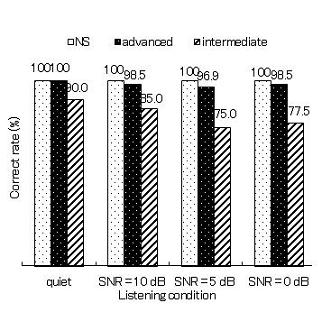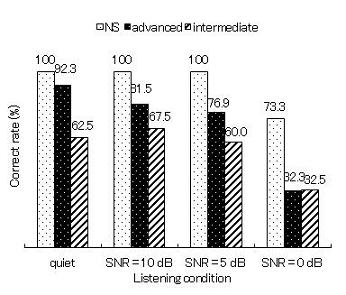背景に雑音がある中で音声を聴き取るのは難しく、特に非母語話者にとっては大変困難となる(Lecumberri & Cooke,2006)。また、学習者の習熟度は外国語音声知覚にとって重要である (Masuda & Arai, 2010)。しかし、いわゆる「バイリンガル」と呼ばれるような上級レベルの学習者でも、特に雑音下ではネイティブと同じような知覚をすることは難しい (Mayo et al., 1997)。例えば、雑音が多く存在する環境であっても、上級学習者は /r/ をネイティブ並みに知覚することができるが、/l/ の知覚は中級学習者並みの正答率に低下する (下図) (Masuda & Arai, 2012)。したがって、異なる習熟度を持つ学習者にとってどの音が、どの環境で知覚が困難になるか調査することは、今後、習熟度別音声訓練教材を作成す る上で大変重要となる。
このデモンストレーションは、日本人が英語の/r/と/l/を聴き取る際に、背景に雑音が入ると聴き取りにくくなることを示す。グラフの横軸は聴取条件を 示す。左のquietは雑音のない静かな環境で、右にいくほど雑音の量が増加する。このデモンストレーションに使われる雑音は「バブルノイズ」と呼ばれ、 「内容は聴き取れないが人が話している」雑音である。このような空間は、例えば騒がしいカフェテリア、パーティー会場などを模擬している。静かな聴取環境 で/r/や/l/が聴き取れていても、雑音が溢れている我々の日常生活では実は外国語音声は聴き取れていないのかもしれない。

| quiet | SNR=10dB | SNR=5dB | SNR=0dB | |
|---|---|---|---|---|
| /r/ |

| quiet | SNR=10dB | SNR=5dB | SNR=0dB | |
|---|---|---|---|---|
| /l/ |
- Lecumberri, M.L. and Cooke, M., Effect of masker type on native and non-native consonant perception in noise, Journal of the Acoustical Society of America, 119 (4), 2445-2454, 2006.
- Masuda, H. and Arai, T., Processing of consonant clusters by Japanese native speakers: Influence of English learning backgrounds, Acoustical Science and Technology, 31(5), pp. 320-327, 2010.
- Masuda, H. and Arai, T., Perception of /r/ and /l/ in quiet and multi-speaker babble noise by Japanese and English native listeners, Proceedings of the Spring Meeting of Acoustical Society of Japan 2012, pp.477-480, 2012.
- Mayo, L.H., Florentine, M. and Buus, S., Factors affecting the recognition of words in a second language, Bilingualism: Language and Cognition, 3 (1), 55-67, 2000.